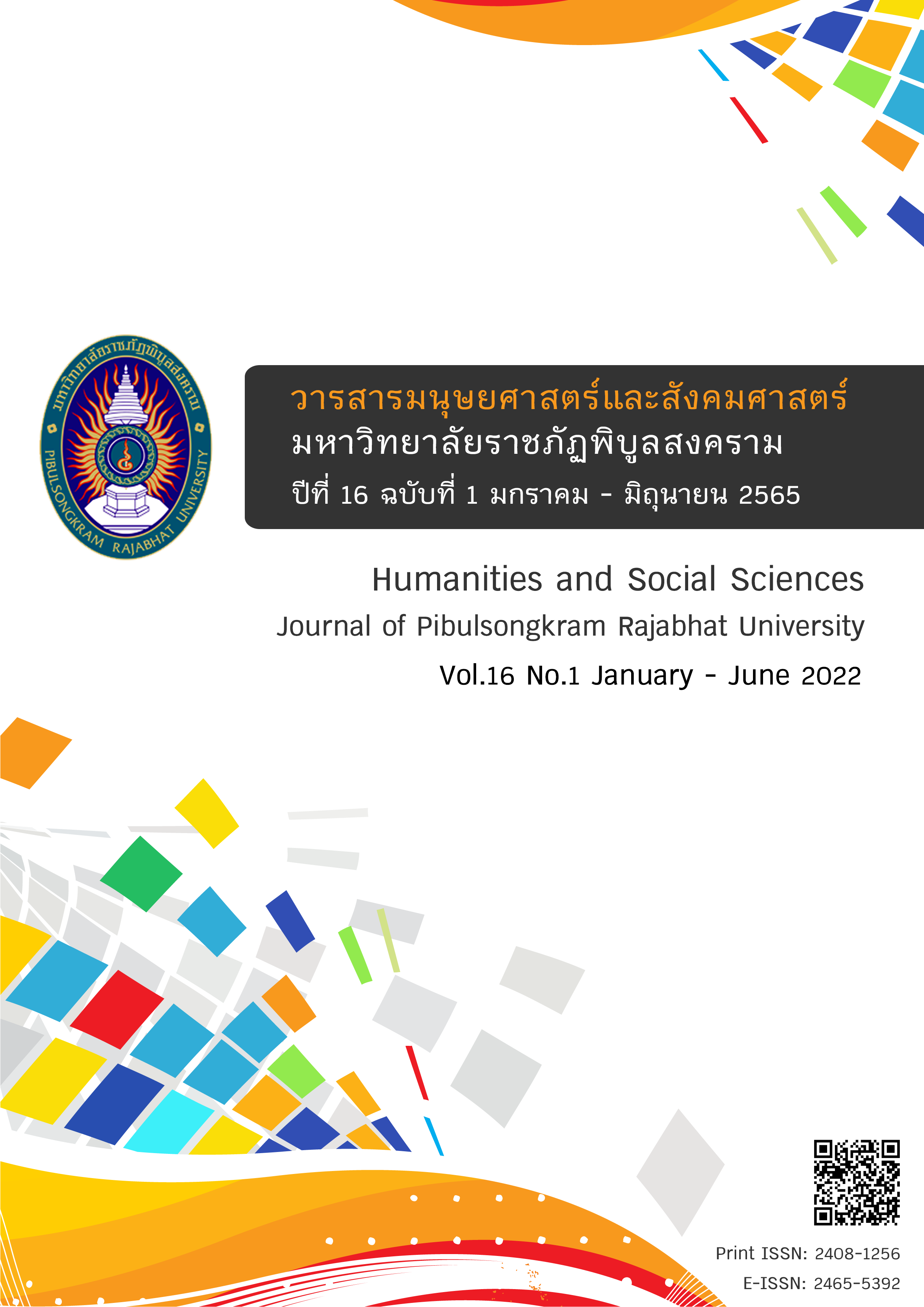Prayers, Happiness and Mental Health of Thai Buddhists
DOI:
https://doi.org/10.14456/psruhss.2022.3Keywords:
Prayers, Happiness, Mental health, BuddhistsAbstract
This article aims to study and examine the relationships between demographic and social factors, prayers, happiness, and mental health of Thai Buddhists. The study used quantitative research and qualitative research. Quantitative data from a national survey in 2014 by the National Statistical Office are used. The samples are 30,997 Buddhists aged 15 years old and over. The Logistic regression analysis is used in this study. Qualitative data were collected using an in-depth interview method among 29 cases who pray regularly. The quantitative results found a positive and statistically significant correlation between prayers, happiness, and mental health, controlling for socio-demographic variables. In addition, the prayer has a chance to be happier and mentally healthy than those who do not pray. The qualitative reveals that praying is mindfulness during prayer which brings them calmness and happiness. Finally, prayers are an alternative activity to apply the benefits of prayers for happiness and mental health, and praying is appropriate to everyone.
References
จุฑาทิพย์ อุมะวิชนี. (2552). ตำนานบทสวดมนต์. กรุงเทพฯ: โรงพิมพ์ธรรมสาร.
ฐิตวี แก้วพรสวรรค์, กมรพร แก้วสวรรค์, และถิรพร ตั้งจิตติพร. (2555). ปัจจัยที่มีผลต่อความเป็นผู้มีสติของวัยรุ่นไทย. วารสารสมาคมจิตแพทย์แห่งประเทศไทย, 57(4), 403 - 412.
ฐิติยา เนตรวงษ์, และรัชฎาพร ธิราวรรณ. (2562). การใช้โปรแกรมส่งเสริมสุขภาพผู้สูงอายุตามหลักวิถีพุทธที่ส่งผลต่อสุขภาพจิตที่ดีของผู้สูงอายุ. วารสารวิทยาลัยราชสุดาเพื่อการวิจัยและพัฒนาคนพิการ, 15(1), 50-62.
ทัศนา จิรสิริธรรม. (2552). ศึกษาการสวดมนต์แปลเพื่อการบรรเทาทุกข์ทางใจ: กรณีศึกษาผู้เข้าร่วมโครงการอยู่เย็นเป็นสุขพ้นทุกข์ร่วมกัน ณ เสถียรธรรมสถาน (วิทยานิพนธ์ปริญญามหาบัณฑิต). กรุงเทพฯ: มหาวิทยาลัยมหาจุฬาลงกรณราชวิทยาลัย.
ทัศนีเวศ ยะโส. (2558). สวดมนต์และสมาธิบำบัดเพื่อการรักษาโรค. สืบค้น 20 กันยายน 2558, จากhttps://is.gd/sLhpxA
เบญมาศ ตระกูลงามเด่น, และสุรีพร ธนศิลป์. (2555). ผลของโปรแกรมการจัดการอาการที่เน้นการสวดมนต์ต่ออาการปวดของผู้ป่วยมะเร็งระยะสุดท้าย. วารสารสำนักการแพทย์ทางเลือก, 5(2), 30-42.
พรทิพย์ ปุกหุต, และทิตยา พุฒิคามิน. (2555). ผลของการสวดมนต์บำบัดต่อความวิตกกังวลและความผาสุกทางจิตวิญญาณในผู้ป่วยมะเร็งเต้านมระยะรับการรักษา. วารสารสมาคมพยาบาลแห่งประเทศไทย สาขาภาคตะวันออกเฉียงเหนือ, 30(2), 122-130.
พระศักดิธัช สํวโร. (2562). รูปแบบและกระบวนการดูแลผู้ป่วยระยะสุดท้ายตามแนวพระพุทธศาสนาของประชาชนในจังหวัดแพร่. วารสารวิชาการธรรมทรรศน์, 19(2), 175-188.
พินิจ รัตนกุล. (2548). สวดมนต์ สมาธิ วิปัสสนา รักษาโรคได้. กรุงเทพฯ: โรงพิมพ์มหามกุฏราชวิทยาลัย ในพระบรมราชูปถัมภ์
เยาวรัตน์ มัชฌิม, วราภรณ์ คงสุวรรณ, และตติกร นิลมานัต. (2562). ประสบการณ์การสวดมนต์ของผู้ป่วยมะเร็ง: การศึกษาเชิงปรากฏการณ์วิทยา. วารสารพยาบาลสงขลานครินทร์, 36(3), 23-35.
รศรินทร์ เกรย์, วรชัย ทองไทย, และเรวดี สุวรรณนพเก้า. (2553). ความสุขเป็นสากล. นครปฐม: สถาบันวิจัยประชากรและสังคม มหาวิทยาลัยมหิดล.
วรรณวิสาข์ ไชยโย. (2555). ทรรศนะเรื่องความสุขในผู้สูงอายุ: กรณีศึกษาบ้านวัยทองนิเวศน์. วารสารมนุษยศาสตร์สาร, 13(1), 16-30.
ศิลีญา แก้วเหล็ก. (2550). ผลการดำเนินโครงการดูแลผู้ป่วยด้านจิตวิญญาณ ธรรมะพัฒนาชีวิต ฝึกจิตเข้มแข็ง ใน การประชุมวิชาการการป้องกันปัญหาการฆ่าตัวตาย ครั้งที่ 2 “เรียนรู้เพื่อการบำบัดโรคซึมเศร้าและการป้องกันปัญหาการฆ่าตัวตาย” วันที่ 25-28 กรกฎาคม 2550 (น. 157). เชียงราย: โรงแรมดุสิตไอส์แลนด์ รีสอร์ต.
สมเด็จพระพุฒาจารย์ พรหมรังสี. (ม.ป.ป.). อมตะธรรม: ประวัติการสวดมนต์. สืบค้น 13 ตุลาคม 2557, จาก www.kanlayantam.com/sara/sara/64.html
สมพร กันทรดุษฎี เตรียมชัยศรี. (2552). กลไกของการปฏิบัติสมาธิ. สืบค้น 13 ตุลาคม 2557, จาก http://thaicamdb.info/article_doc.php?article=41
สำนักงานสถิติแห่งชาติ. (2558). การสำรวจสภาวะทางสังคม วัฒนธรรมและสุขภาพจิต (ความสุข) คนไทย พ.ศ. 2557. กรุงเทพฯ: กระทรวงเทคโนโลยีสารสนเทศและการสื่อสาร.
สุภาพ หอมจิตร. (2554). สวดมนต์อานิสงส์ครอบจักรวาล. กรุงเทพฯ: เลี่ยงเซียง.
สุภาพรรณ ณ บางช้าง. (2529). วิวัฒนาการงานเขียนภาษาบาลีในประเทศไทย: จารึก ตำนาน พงศาวดาร สาส์น ประกาศ. กรุงเทพฯ: มูลนิธิมหามกุฏราชวิทยาลัย.
อภิชัย มงคล, ยงยุทธ วงศ์ภิรมย์ศานติ์, ทวี ตั้งเสรี, วัชนี หัตถพนม, ไพรวัลย์ ร่มซ้าย, และวรวรรณ จุฑา. (2552). การพัฒนาและทดสอบดัชนีชี้วัดสุขภาพจิตคนไทย (Version 2007). กรุงเทพฯ: โรงพิมพ์ชุมนุมสหกรณ์การเกษตรแห่งประเทศไทย.
Andersson, G. (2008). Chronic pain and praying to a higher power: useful or useless?. Journal of religion and health, 47(2), 176-187.
Belding, J. N., Howard, M. G., McGuire, A. M., Schwartz, A. C., & Wilson, J. H. (2010). Social buffering by God: Prayer and measures of stress. Journal of religion and health, 49(2), 179-187.
Dehghani, K. H., Zare Rahimabadi, A., Pourmovahed, Z., Dehghani, H., Zarezadeh, A., & Namjou, Z. (2012). The effect of prayer on level of anxiety in mothers of children with cancer. Iranian Journal of Pediatric Hematology and Oncology, 2(2), 78-83.
George, L. K. (2010). Still happy after all these years: Research frontiers on subjective well-being in later life. Journals of Gerontology Series B: Psychological Sciences and Social Sciences, 65(3), 331-339.
Gray, D. B., Hollingsworth, H. H., Stark, S., & Morgan, K. A. (2008). A subjective measure of environmental facilitators and barriers to participation for people with mobility limitations. Disability and rehabilitation, 30(6), 434-457.
Maltby, J., Lewis, C. A., & Day, L. (2008). Prayer and subjective well-being: The application of a cognitive-behavioural framework. Mental Health, Religion and Culture, 11(1), 119-129.
Robbins, M., Francis, L. J., & Edwards, B. (2008). Prayer, personality and happiness: A study among undergraduate students in Wales. Mental Health, Religion and Culture, 11(1), 93-99.
Downloads
Published
How to Cite
Issue
Section
License
Copyright (c) 2020 Humanities and Social Sciences Journal of Graduate School, Pibulsongkram Rajabhat University

This work is licensed under a Creative Commons Attribution-NonCommercial-NoDerivatives 4.0 International License.
Any articles or comments appearing in the Journal of Humanities and Social Sciences, Rajabhat Phibulsongkram University, are the intellectual property of the authors, and do not necessarily reflect the views of the editorial board. Published articles are copyrighted by the Journal of Humanities and Social Sciences, Rajabhat Phibulsongkram University.









